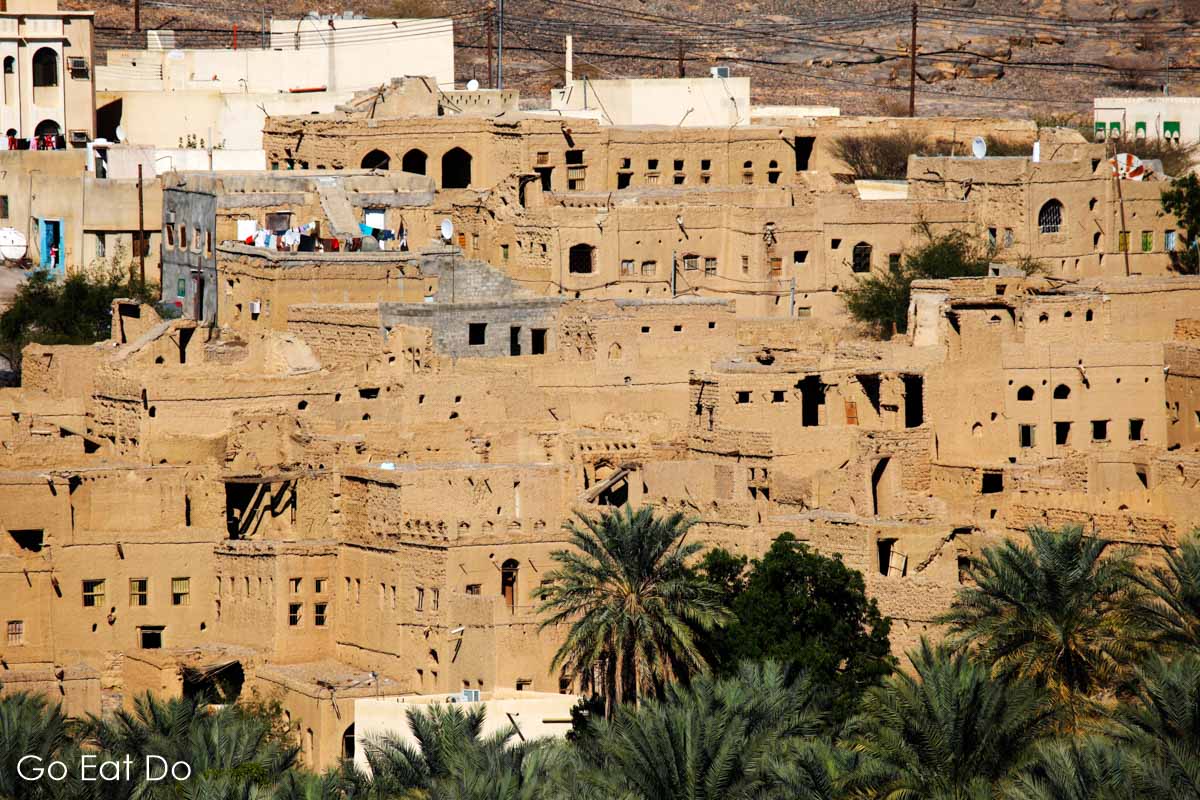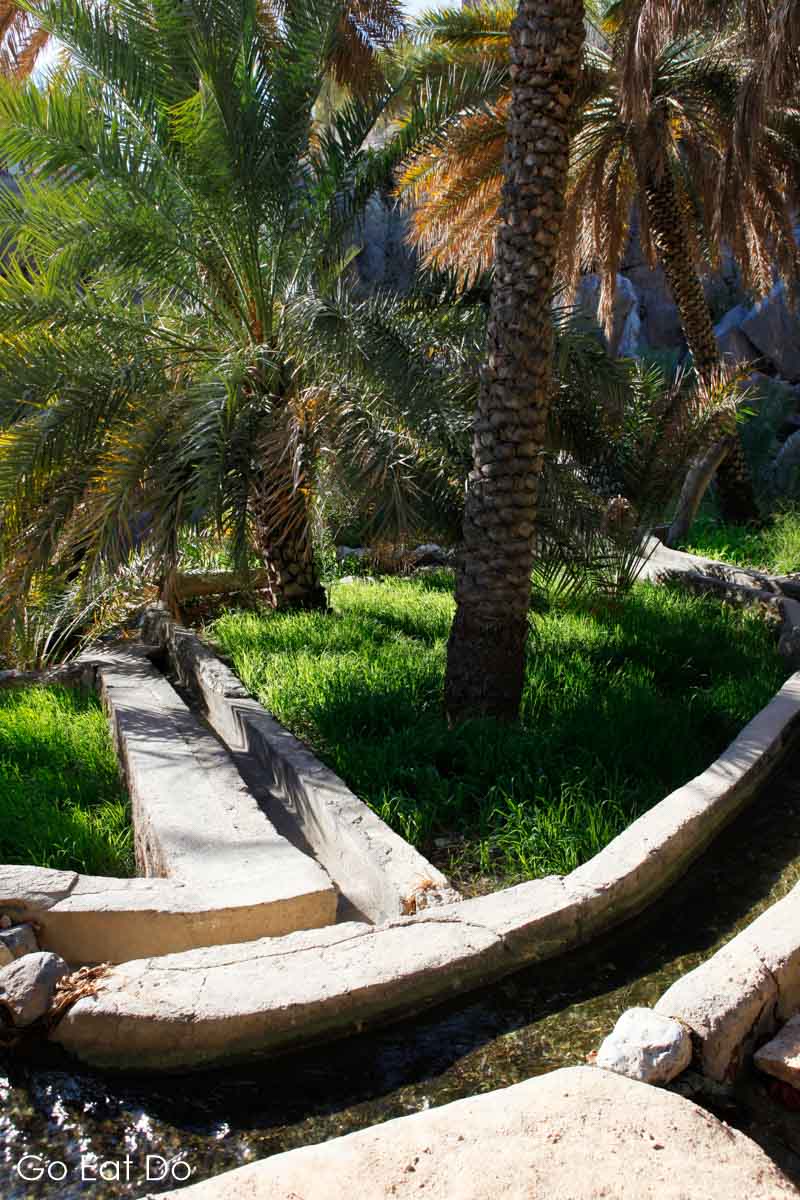Stuart Forster looks at the sustainable and environmentally friendly nature of the aflaj irrigation systems of Oman.
Disclosure: Some of the links on banner adverts below are affiliate links, meaning, at no additional cost to you, I will earn a commission if you click through and make a purchase.
Over recent years increased value has been placed on environmentally sound projects with a strong community base. If Oman’s aflaj irrigation system was built from scratch today it might well be regarded as a shining example of how a civil engineering project can be implemented according to contemporary and sustainable environmental principles. Yet the canals and waterways are centuries old.

Aflaj irrigation sysmem in Oman
During summer, the temperatures in northern Oman soar beyond 50°C (122°F). An effective system of providing water for people, livestock and crops is essential in order to sustain and nurture life in a naturally arid landscape.
Civil engineers came up with a workable solution centuries ago. Who those people were and precise details as to when construction began on the irrigation system has been lost over time. Unfortunately, no written records survive about the origins of Oman’s aflaj system. Several of the canals date from around 500AD yet others are much older. Remarkably, archaeological research suggests that the earliest examples were built more than 4,000 years ago:
Despite the sparse historic details, experts agree that Oman’s aflaj irrigation system is an innovative and ingenious method of providing water in a challenging environment. The word falaj refers to a single irrigation channel while aflaj is the plural term. This explains why you may hear reference to falaj irrigation system too.
Approximately 3,000 aflaj exist, channelling water to tanks in desert villages and towns. They also guide water into carefully tended date palm and citrus fruit plantations that seemingly defy the ferocious summer heat of the Arabian Peninsula.

The aflaj UNESCO World Heritage Site
The historic and cultural value of the Omani aflaj system gained widespread international recognition in 2006 when UNESCO inscribed the networks of the Batinah, Dakhiliya and Sharqiya districts onto its list of world heritage sites. In some places the aflaj are not visible to the naked eye, running underground to minimise evaporation. In other places, the line of a falaj is marked by a series of watchtowers, built to guard over the precious resource within.
Some of the best examples of aflaj can be seen in the small towns and remote villages of the Hajjar Mountains above Nizwa. The spine of this mountain chain runs parallel to the coast, sweeping down from Oman’s border with the United Arab Emirates to the towns of Samail and Izki, the latter of which is just 138 kilometres from Muscat.
The mountains offer a dramatic and often photogenic landscape; craggy in places, rock-strewn in others. The dusty reds and oranges of the slopes occasionally open to show the stratification of rock which is being pushed imperceptibly upwards as the tectonic plates of Africa and Asia grind together.

Driving between Muscat and Nizwa
These days driving on Oman’s modern highways means that the 174km between Muscat, the present capital, and Nizwa, the previous holder of that title, takes under two hours. For centuries, this journey would have kept the drivers of camel caravans occupied for days.
Bahla, 40 kilometres to the west of Nizwa, lies on one of the Arabian Peninsula’s historic caravan routes. The highly regarded silverwork, pottery and indigo of the city ensure that traders continue to swing by to pick up wares.
During the Middle Ages, local rulers felt compelled to build a grand fortress to protect the artisans who provided the source of the region’s wealth. Since 1987 that structure has been classified as a UNESCO World Heritage Site. A number of falaj irrigation channels can be seen running through palm groves on the outskirts of Bahla.

Visiting historic Al Hamra
One of the most attractive towns in the region is Al Hamra, built on the slope of a barren hillside and remarkable because it has no defensive walls. The sun bakes down on the Al Hamra’s multi-storey clay houses, riddling their reddish facades with deep fissures.
The paint on the town’s carved wooden doors and green shutters is flaked and aged. Nevertheless, the goats that wander through the town’s lanes are not thirsty nor do the date palms miss a crop; all because of the careful management of water via the canals which run along the foot of the hill.

Local farmers need to work closely with one another, to coordinate and manage their needs while ensuring that the overall demand of the community does not exceed the resources available:
Climbing further into the mountains, the village of Misfah has only been open to foreign visitors for a handful of years. It’s difficult to put a precise age on the stone houses, some of which are centuries old and built into the hillside. They are separated by narrow, steeply-stepped lanes that provide cooling shade.
Bedu men can be seen wearing traditional Omani dishdasha robes and mussah turbans with curving khanjar daggers – without which the national dress is not complete – tucked into their belts. The place has the feel of a living museum yet the satellite dishes perched on a number Misfah’s houses indicate that the village is slowly modernising.

Misfah in Oman
That modernisation does not need to stretch to the irrigation system, which ensures that a shock of lush green can be seen around the houses. The palm trees and citrus groves of Misfah might at first seem incongruous in such an otherwise arid landscape. They are testimony to man’s ability to innovate, adapt and survive.
Between a number of houses, water flows into a tank. Local lads use it as a swimming pool, shrieking with excitement as they jump in; showing off to passing visitors while cooling off. Water may be essential to life but, even here, it’s also a source of pleasure.

Water babbles along aflaj ingeniously shaded by the foliage of gently swaying palm leaves. The effect is to moderate the temperature and provide a fertile environment for crops:
Seeing this helps explain what it is that is so remarkable about Oman’s aflaj system and why UNESCO chose to inscribe it on the list of world heritage sites seven years ago.

Bait Al Falaj in Muscat
You don’t necessarily have to journey outside of Oman’s capital to see examples of aflaj. The Bait Al Falaj fort is located in Muscat and is well-known as the home of the Sultan’s Armed Forces Museum. This attraction will appeal to you if you’re looking to learn more about Omani military history and see artefacts relating to tribal warfare and the periods of Portuguese and British domination.
The museum is attractively laid out and was once a royal residence. The Battle of Bait Al Falaj was fought here in 1915. Fresh spring water flows along the falaj channels in the gardens, providing sustenance to groves of acacia and palm trees.

Travel to Oman
Stuart flew direct from London Heathrow to Muscat with Oman Air. British Airways also operates direct flights between Heathrow and Muscat International Airport.
Qatar Airways, Gulf Air and Turkish Airlines fly between London and Muscat via their respective hubs in Doha, Bahrain and Istanbul:
Travel Supermarket offers a range of holidays:
The map below shows Oman’s location on the Arabian Peninsula:

Hotels in Nizwa, Oman
Search for accommodation in and around Nizwa via the Booking.com website:
Booking.com
Search for deals on hotels in Oman via Agoda:
Further Information
See the Oman Tourism website.
Enjoy this post on Oman’s aflaj irrigation system? Here’s a look at shopping in Muscat.
Stuart Forster, the author of this post, visited Oman during an event organised by the British Guild of Travel Writers.
If you enjoyed this post why not sign up for the free Go Eat Do newsletter? It’s a hassle-free way of getting links to posts on a monthly basis.
‘Like’ the Go Eat Do Facebook page to see more photos and content.
A version of this post was initially published on Go Eat Do on 1 May 2013.






Waldirde Souza Junior
February 10, 2017 at 00:26It is a marvellous thing the ability of this ancient, historic and very sage people into edifying so majestic and important building who provides food and watering to their citizens, and this into a thousands years ago; through this engine they make possible life and irrigation-systems in the desert with so much important cultivation ,crops and making possible too,an efficient and successful commerce.
Stuart Forster
February 13, 2017 at 09:27Indeed, it’s a wonderful system to see and its story is truly impressive.